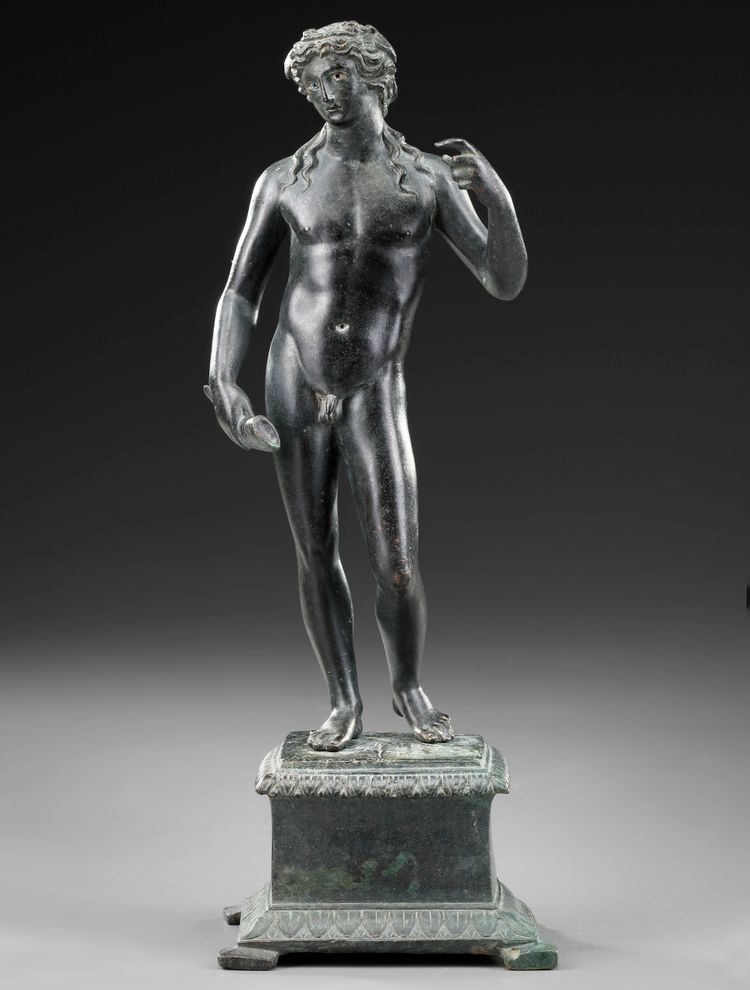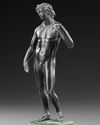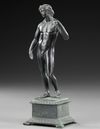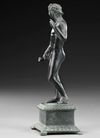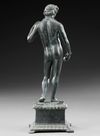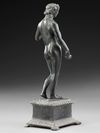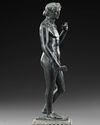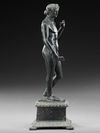A ROMAN BRONZE STATUETTE OF APOLLO CARNEUS, CIRCA 1ST-2ND CENTURY A.D.
An elegant standing statuette of Apollo holding a ram's horn in his right hand and holding his left arm upwards, possibly one having held a brand or other attribute. He stands in a typical pose for a Roman god with his right leg supporting his weight. The statuette stands on a cast bronze square base with decorated cornices. A beautiful bronze in perfect preservation of a very rare subject. Size: 25.5 cm. including base. Weight: 1545 grams.
CONDITION
Very fine condition and glassy dark green patina.
PROVENANCE
Previously in Gorny and mosch auction in Munich, lot 102. sale140. 21-June-2005. Formerly in an old collection of Mr E.R. Acquired in the early 1970s.
CATALOGUE NOTE
The subject of this bronze is extremely interesting as it seems to represent Apollo Carneus or Karneios in Greek, a Spartan incarnation of the god whose cult was widespread among the Dorian Greeks. Such statuettes were often placed in domestic shrines where the owner of the property would ask the gods for protection and well being. In this case the owner might well have been a adherant of this cult and might suggest that he had connections with the Peloponnesus. It seems to be a sole survivor from the Roman period as Apollo Karneios is most often found on Greek coins stuck either in the Peloponnesos or its colonies in Southern Italy. As such it is an extremely interesting object meriting further study and discussion.
"Carneüs, whom they surname 'of the House,' had honours in Sparta even before the return of the Heracleidae (ed. the descendants of Iraklís, i.e. Hercules), his seat being in the house of a seer, Crius (Ram) the son of Theocles. The daughter of this Crius was met as she was filling her pitcher by spies of the Dorians, who entered into conversation with her, visited Crius and learned from him how to capture Sparta. The cult of Apollo Carneüs has been established among all the Dorians ever since Carnus, an Acarnanian by birth, who was a seer of Apollo. When he was killed by Hippotes the son of Phylas, the wrath of Apollo fell upon the camp of the Dorians; Hippotes went into banishment because of the bloodguilt, and from this time the custom was established among the Dorians of propitiating the Acarnanian seer. But this Carnus is not the Lacedaemonian Carneüs of the House, who was worshipped in the house of Crius the seer while the Achaeans were still in possession of Sparta. The poetess Praxilla represents Carneüs as the son of Europa, Apollo and Leto being his nurses." (trans. W. H. S. Jones, 1918)
